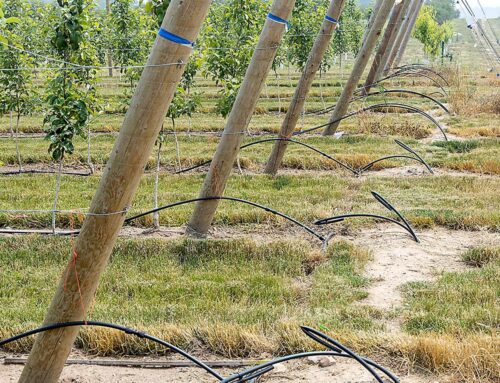
Researchers collect apples for analysis after treatment in a split dump tank system. (Courtesy Ines Hanrahan)
Scientists in Washington have been doing research to help fruit packers ensure fruit is clean when it goes in the box and reduce their food safety risks.
Dr. Ines Hanrahan, project manager with the Washington Tree Fruit Research Commission, has been working with Dr. Karen Killinger, former food safety specialist with Washington State University, to evaluate the most effective microbial controls for packing houses and identify new products and approaches.
Dump tank
Controlling microbes in the dump tank is difficult because of all the soil (organic matter) that is dumped with the fruit. Organic matter binds to and inactivates chlorine.
Hanrahan said it is not uncommon for packers to just have one dump tank and change the water once a week. “This is where you can lose control, and you then start contaminating the fruit,” she said.
Ideally, the dump system should have two parts beginning with a small tank where the bins are initially submerged. Then, the fruit would go under a rinse bar and into a separate, cleaner dump tank.
“It’s much easier to control your chlorine levels and prevent cross-contamination in the second dump tank, and you may get a microbial reduction, depending on your management system for the dump tank and flume system,” she said.
Packers might not have room for two dump tanks on their existing lines, Hanrahan said. “But it’s easy, if you’re building a line, to consider that, and it doesn’t cost a lot of money to do it. Just a little alteration makes a huge difference for food safety.
“If you have two separate water systems, a dump tank followed by a separate flume system, you can switch the water in the first dump tank very frequently. You don’t have to dump all the water in the system at one time. It’s easy to replenish that tank and keep it clean. Determining an appropriate water change schedule with more frequent water changes can improve safety.”
The oxidation/reduction potential (ORP) can be used as an indicator of how much active chlorine is in the system to help control microbes, so it’s important to measure the ORP with a meter or probe to make sure it stays in the right range, she said.
However, readings can be affected by the placement and accuracy of the instrument as well as frequency of calibration.
For example, if readings are taken close to the chlorine injection system, perhaps because it’s a convenient location, they might not accurately indicate the overall ORP level throughout the entire system.
The scientists recommend aiming for ORP readings higher than the minimum target levels to control microbes to account for variability in readings and the accuracy of the probes. Meters need to be maintained properly.
Spray bars
A spray bar system can be an effective way to reduce the microbial load on fruit. However, Hanrahan said many packing lines don’t have a spray bar or, if they do, it’s not long enough. “If you have a spray bar that applies a treatment directly to the fruit for a few seconds, that’s clearly too short.”
Research has shown that generic (non-pathogenic) Escherichia coli on apples can be reduced by more than 90 percent when 60 to 80 parts per million of peroxyacetic acid are directly applied to the fruit for at least 30 seconds, with or without soap.
Some packers have changed the layout of their packing lines to add spray bars or created space for longer spray bars.
“This is a nice outcome, so you can get microbial reductions on the packing line,” Hanrahan said.
The scientists emphasize that microbial control must be maintained throughout the packing process. In a study at a cooperating packing house, they found no evidence of coliforms or generic E. coli in the pre-size dump tank water system, but the lack of a sanitizer in the flume system and bin fillers resulted in increasing microbial loads on fruit after pre-sizing.
They also monitored microbe levels after each step during final packing: dump tank, soap spray bar, hyperwash, water rinse spray bar, fans, wax application and dryer. The step that appeared to reduce microbes the most was drying.
Research is now underway to further study how drying during the packing process affects microorganisms on fruit.
Overall, progress is being made on identifying steps in a packing system that can improve microbial control and offer opportunities for microbial reduction, Killinger and Hanrahan report. •
– by Geraldine Warner






[…] Warner, G. (2016 January 14). Food safety research focuses on packing. Good Fruit Grower. https://www.goodfruit.com/food-safety-research-focuses-on-packing/ […]